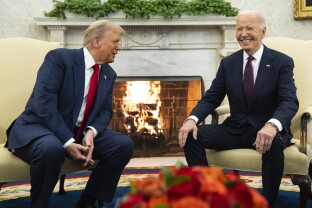The Food and Drug Administration has issued a blitz of high-impact new rules in the last days of the Biden administration. Now agency officials just need to convince Donald Trump that they should stick.
Some of the new rules, like the ban on Red Dye No. 3, are likely popular with both the outgoing and incoming administrations. Robert F. Kennedy Jr., Trump’s nominee to lead Health and Human Services, has said he will make reducing food additives a priority, and praised protesters rallying in October against food dyes. By issuing the new rule now, President Joe Biden’s FDA has taken one unpopular food additive off the docket for Kennedy and FDA commissioner nominee Marty Makary.
Other rules, like a proposed restriction on the amount of nicotine in tobacco products, will likely face opposition from the incoming administration — meaning the last-minute new rule effectively serves as a challenge from the current administration to the new one on whether or not they want to publicly state that cigarettes should be extra addictive. While Trump and Kennedy haven’t included nicotine reductions in their “Make America Healthy Again” platform, efforts to enact a similar rule during the first Trump administration failed. And Kennedy, though an ardent advocate for the reduction of toxins in the U.S. food supply, has been spotted with nicotine replacement pouches — which, incidentally, the FDA also ruled on this week, saying that the popular brand Zyn could begin marketing.
The FDA also proposed requiring front-of-package nutrition labels on packaged foods, which would seem to align with Kennedy’s goal of improving the American diet in an effort to reduce chronic disease.
What the rule — or really any of the others — doesn’t align with, though, is Elon Musk’s calls for a drastic reduction in the number of federal regulations.
One former FDA official told NOTUS that the timing of these new rules may have more to do with the end of the Biden administration than the second coming of Trump: Many of these seemingly last-minute policy proposals have been in the works for months, or even years.
“It’s not at all surprising or unusual that at the end of an administration, they will work hard to get out those priorities that they’ve already invested a lot of time and energy on out the door before the change of administration,” the official said.
But the official also said that while the FDA rule-making process is typically lengthy, “there are ways to compress that timeline, primarily in the clearance steps” that come after the public review periods, when the Department of Health and Human Services and the White House Office of Management and Budget review the rule.
An FDA spokesperson told NOTUS that he was unable to comment on the timing of the new rules, or whether the agency had expedited the process in order to get the rules out before Jan. 20.
But in a statement released by the FDA, Commissioner Robert Califf seemed to acknowledge the cross-administration support needed to actually implement the new nicotine limit rule.
“Multiple administrations have acknowledged the immense opportunity that a proposal of this kind offers to address the burden of tobacco-related disease,” Califf said. “I hope we can all agree that significantly reducing the leading cause of preventable death and disease in the U.S. is an admirable goal we should all work toward.”
—
Margaret Manto is a NOTUS reporter and an Allbritton Journalism Institute fellow.
Sign in
Log into your free account with your email. Don’t have one?
Check your email for a one-time code.
We sent a 4-digit code to . Enter the pin to confirm your account.
New code will be available in 1:00
Let’s try this again.
We encountered an error with the passcode sent to . Please reenter your email.


